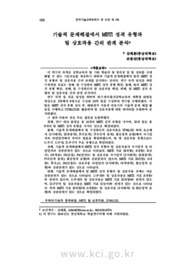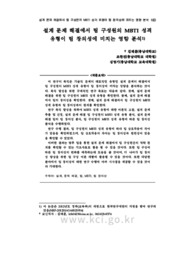

-
미리보기
서지정보
· 발행기관 : 한국기술교육학회
· 수록지 정보 : 한국기술교육학회지 / 12권 / 2호 / 160 ~ 182페이지
· 저자명 : 김태훈, 조한진
초록
이 연구의 목적은 공학교육의 팀 기반 학습의 팀 창의성 및 팀 성과를 극대화할 수 있는 기초자료를 제공하기 위하여 기술적 문제해결에서 팀의 MBTI 성격 유형과 팀 상호작용 간의 관계를 분석하는 것이다. 연구 목적 달성을 위한 구체적인 목표는 첫째, 팀 구성원의 MBTI 성격 유형 확인, 둘째, 팀의 MBTI 성격 유형 확인, 셋째, 팀 구성원간의 팀 상호작용 확인, 넷째, 팀 MBTI 성격 유형과 팀 상호작용 간의 관계 분석이다.
연구 목적 및 목표 달성을 위하여 전기‧전자‧통신공학교육과 재학생 41명을 대상으로 2명에서 6명으로 구성된 10개 팀을 구성하여 연구를 수행하였다. 각 팀은 MBTI 성격 유형 검사 후, 태양전지 자동차 만들기의 기술적 문제 해결 활동을 수행하고 SYMLOG를 활용하여 팀 상호작용에 대한 데이터를 수집하여 분석하였다.
그 결과 다음과 같은 주요 결론을 도출하였다.
첫째, 연구 대상 41명은 총 14개의 MBTI 성격 유형을 가지며, 10개 팀은 총 9개의 팀 MBTI 성격 유형을 가지는 것으로 확인되었다.
둘째, 기술적 문제해결에서 팀 구성원간의 상호작용은 SYMLOG 하위 요소에서 U(지배적), D(복종적), P(우호적), F(수단적 통제), B(감정적 표현)에서 자기인식과 타인인식에서 차이가 있음을 확인하였으며, 팀 별 상호작용 유형으로는 U-P-F, U-P-B, D-P-F가 주요 유형으로 확인되었다.
셋째, 기술적 문제해결에서 MBTI 성격 유형과 팀 상호작용의 자기인식 및 타인인식과 상관관계가 있는 것으로 나타났다. MBTI 지표 E(외향), I(내향), S(감각), iN(직관), Fe(감정), Pe(인식)는 팀 상호작용 자기인식 U(지배적), D(복종적), F(수단적 통제), B(감정적 표현)와 상관관계가 있으며, MBTI 지표 E(외향), I(내향), T(사고), Fe(감정)는 상호작용 타인인식 U(지배적), N(적대적), B(감정적 표현)와 상관관계가 있는 것으로 나타났다.
넷째, 기술적 문제해결에서 팀 MBTI 성격 유형과 팀 상호작용 간에는 서로 상관관계가 있는 것으로 나타났다. U-P-B의 팀 상호작용은 MBTI 지표 I(내향)와 관계가 있으며, U-P-B의 팀 상호작용은 MBTI 지표 E(외향)와 관계가 있으며, D-P-F의 팀 상호작용은 MBTI 지표 S(감각)와 관계가 있는 것으로 나타났다. 특히 MBTI 지표 E(외향)와 I(내향)는 팀 상호작용 U(지배적) 및 B(감정적 표현)와 상관관계가 있는 것으로 확인되었다.영어초록
The purpose of this study is to provide foundational information that can aid the maximization of creativity and productivity of teams in the field of engineering and technology education, through analyzing the relationship between MBTI personality types and team interaction for technological problem solving. Thus, the detailed goals of this study were first, the identification of the MBTI personality types for each of the team members; second, the identification of the MBTI personality type for the team as a group; third, the understanding of team interaction; and fourth, the analysis on the relationship between the team’s MBTI personality type and team interaction.
To achieve the intent of this study, 41 students from the Electric, Electronic, and Communications Engineering Education departments were gathered and divided into 10 groups of 2 to 6 members. Each team first underwent the MBTI Personality Type test, and the teams were then presented with the technological problem solving issue of making a car powered by solar cell. After the teams were problem solving, the SYMLOG was used to gather the data regarding the team’s interaction.
As a result of this study, the following were deduced as the main implications.
First, the 41 participating students showed a total of 14 MBTI personality types and the ten teams showed a total of 9 different team MBTI personality types.
Second, the study showed that given the common technological problem solving task, there was a difference in perception of self and perception of others in the lower dimension criteria of SYMLOG, which includes U(Upward : dominance), D(Downward : Submissiveness), P(Positive : Friendliness), F(Forward : Acceptance of Authority), and B(Backward : Nonacceptance of Authority). In terms of the team interaction types, the U-P-F type, the U-P-B type, and the D-P-F type were the major types of team interaction found within the participating groups.
Third, it was found that there is indeed a correlation between the MBTI personality type and the team interaction’s perception of self and others. The MBTI indices E(Extraversion), I(Introversion), S(Sensing), iN(iNtuition), Fe(Feeling), and Pe(Perceiving) showed a correlation with perception of self in team interaction’s U(Upward : dominance), D(Downward : Submissiveness), F(Forward : Acceptance of Authority), and B(Backward : Nonacceptance of Authority). Similarly, the MBTI indices E(extroversion), I(introversion), T(thinking), and Fe(feeling) showed a correlation with perception of other in team interaction’s U(Upward : dominance), N(Negative : Unfriendliness), and B(Backward : Nonacceptance of Authority).
Fourth, given the issue of technological problem solving, there was a correlation between the team’s MBTI personality type and the team interaction. The U-P-B type team interaction showed a relationship with MBTI index I(Introversion); the U-P-B type team interaction showed a relationship with MBTI index E(Extroversion); and the D-P-F type team interaction showed a relationship with MBTI index S(Sensing). In particular, it was seen that there was correlation between the MBTI indices E(Extroversion) and I(Introversion) with the team interaction factors U(Upward : dominance) and B(Backward : Nonacceptance of Authority).참고자료
· 없음태그
-
자주묻는질문의 답변을 확인해 주세요

꼭 알아주세요
-
자료의 정보 및 내용의 진실성에 대하여 해피캠퍼스는 보증하지 않으며, 해당 정보 및 게시물 저작권과 기타 법적 책임은 자료 등록자에게 있습니다.
자료 및 게시물 내용의 불법적 이용, 무단 전재∙배포는 금지되어 있습니다.
저작권침해, 명예훼손 등 분쟁 요소 발견 시 고객센터의 저작권침해 신고센터를 이용해 주시기 바랍니다. -
해피캠퍼스는 구매자와 판매자 모두가 만족하는 서비스가 되도록 노력하고 있으며, 아래의 4가지 자료환불 조건을 꼭 확인해주시기 바랍니다.
파일오류 중복자료 저작권 없음 설명과 실제 내용 불일치 파일의 다운로드가 제대로 되지 않거나 파일형식에 맞는 프로그램으로 정상 작동하지 않는 경우 다른 자료와 70% 이상 내용이 일치하는 경우 (중복임을 확인할 수 있는 근거 필요함) 인터넷의 다른 사이트, 연구기관, 학교, 서적 등의 자료를 도용한 경우 자료의 설명과 실제 자료의 내용이 일치하지 않는 경우
찾으시던 자료가 아닌가요?
지금 보는 자료와 연관되어 있어요!
문서 초안을 생성해주는 EasyAI



